Performance Management at O'Meara Electronics: A Case Study Report
VerifiedAdded on 2023/01/20
|11
|2871
|48
Report
AI Summary
This report analyzes the performance management and remuneration strategies of O'Meara Electronics, focusing on a case study approach. The study examines the company's current performance management system, diagnosing its strengths and weaknesses, particularly in relation to declining profitability and market position. The report explores the implementation of 360-degree feedback processes and compares them to goal-setting approaches. It identifies key issues such as the lack of employee involvement, the absence of performance appraisals, and the need for a more person-based remuneration system. The analysis includes arguments for the adoption of a 360-degree feedback system and offers recommendations for improving employee performance, recognition, and involvement, ultimately aiming to enhance the company's overall performance and market competitiveness. The report provides a comprehensive overview of the challenges faced by O'Meara Electronics and suggests actionable strategies for improvement.
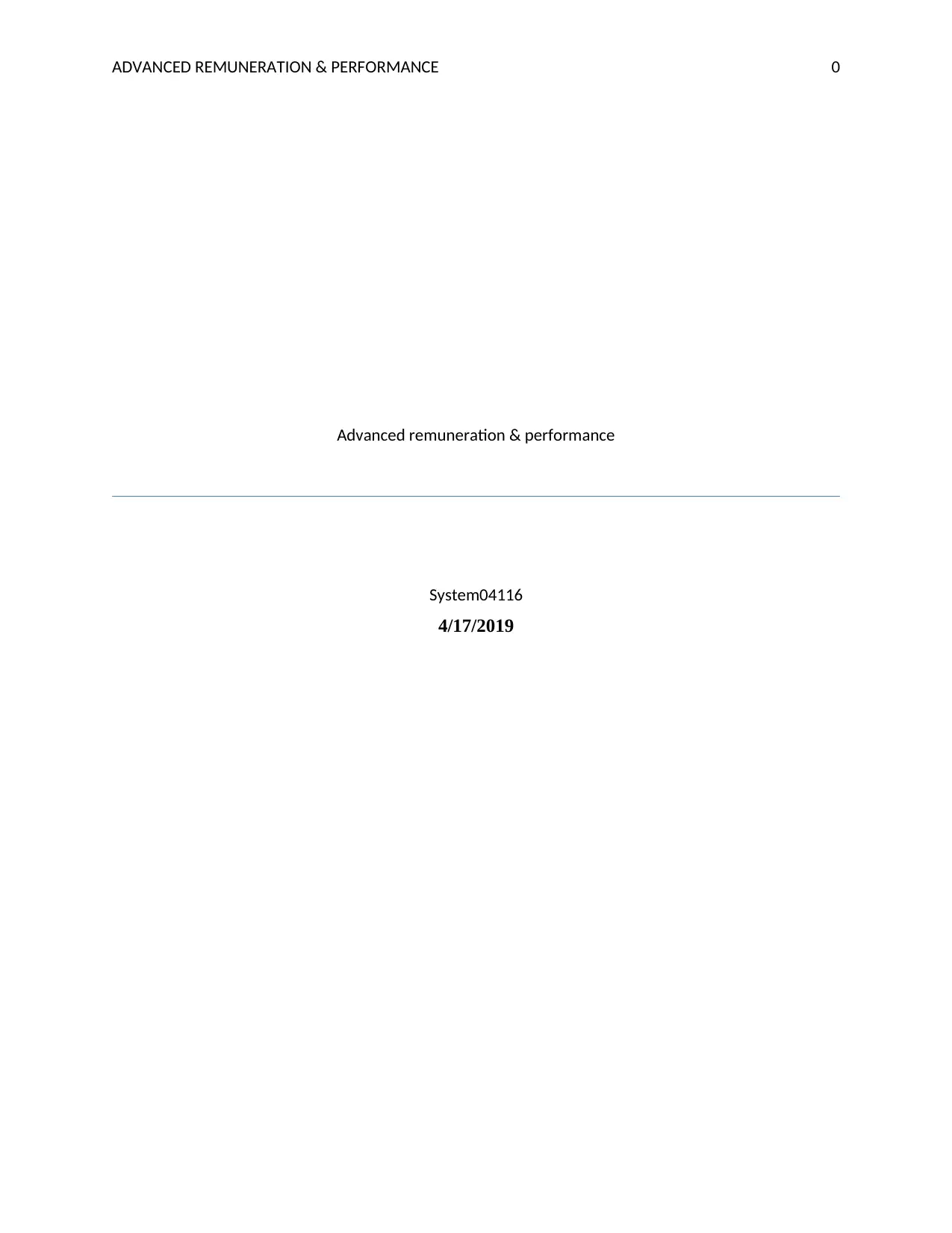
ADVANCED REMUNERATION & PERFORMANCE 0
Advanced remuneration & performance
System04116
4/17/2019
Advanced remuneration & performance
System04116
4/17/2019
Paraphrase This Document
Need a fresh take? Get an instant paraphrase of this document with our AI Paraphraser
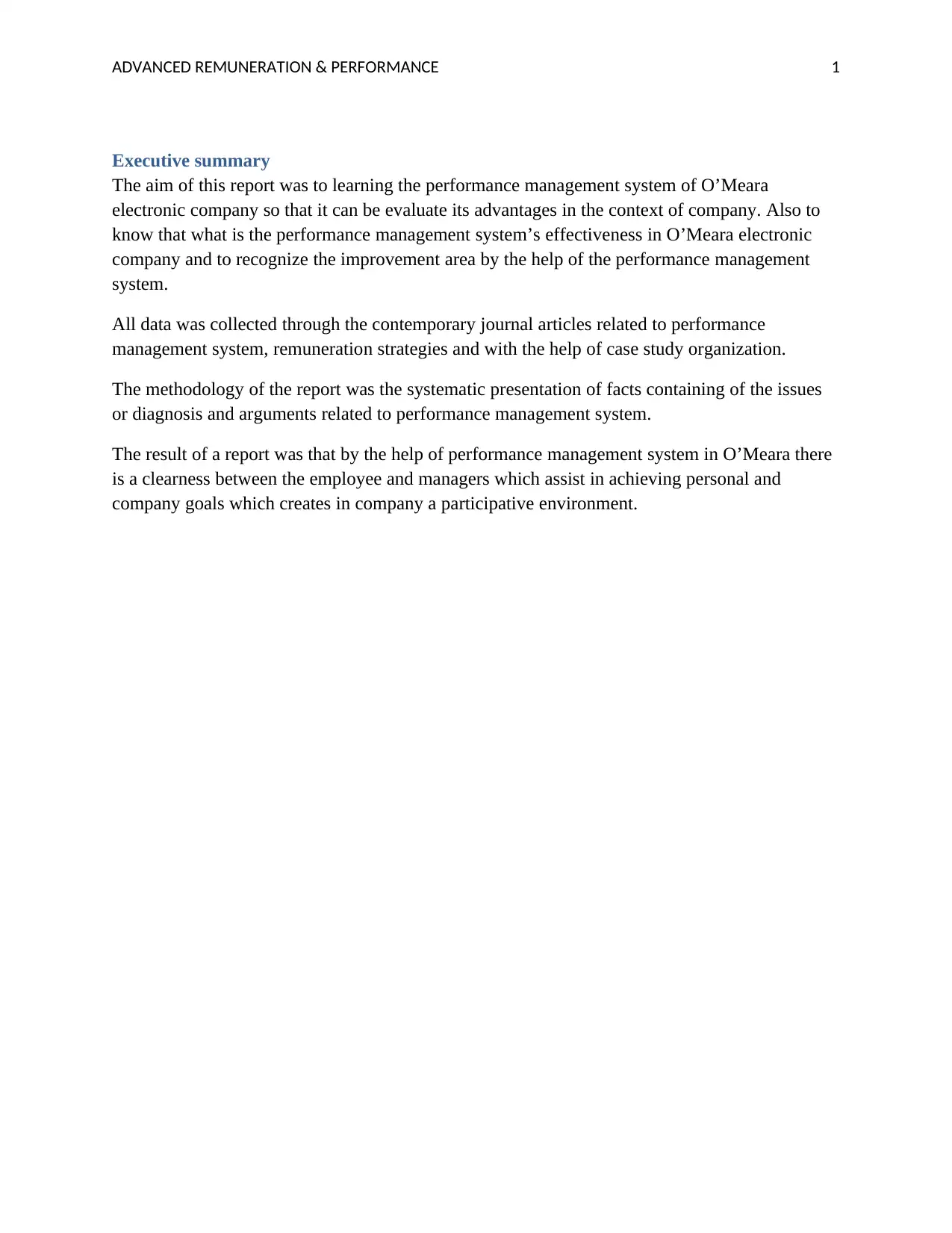
ADVANCED REMUNERATION & PERFORMANCE 1
Executive summary
The aim of this report was to learning the performance management system of O’Meara
electronic company so that it can be evaluate its advantages in the context of company. Also to
know that what is the performance management system’s effectiveness in O’Meara electronic
company and to recognize the improvement area by the help of the performance management
system.
All data was collected through the contemporary journal articles related to performance
management system, remuneration strategies and with the help of case study organization.
The methodology of the report was the systematic presentation of facts containing of the issues
or diagnosis and arguments related to performance management system.
The result of a report was that by the help of performance management system in O’Meara there
is a clearness between the employee and managers which assist in achieving personal and
company goals which creates in company a participative environment.
Executive summary
The aim of this report was to learning the performance management system of O’Meara
electronic company so that it can be evaluate its advantages in the context of company. Also to
know that what is the performance management system’s effectiveness in O’Meara electronic
company and to recognize the improvement area by the help of the performance management
system.
All data was collected through the contemporary journal articles related to performance
management system, remuneration strategies and with the help of case study organization.
The methodology of the report was the systematic presentation of facts containing of the issues
or diagnosis and arguments related to performance management system.
The result of a report was that by the help of performance management system in O’Meara there
is a clearness between the employee and managers which assist in achieving personal and
company goals which creates in company a participative environment.
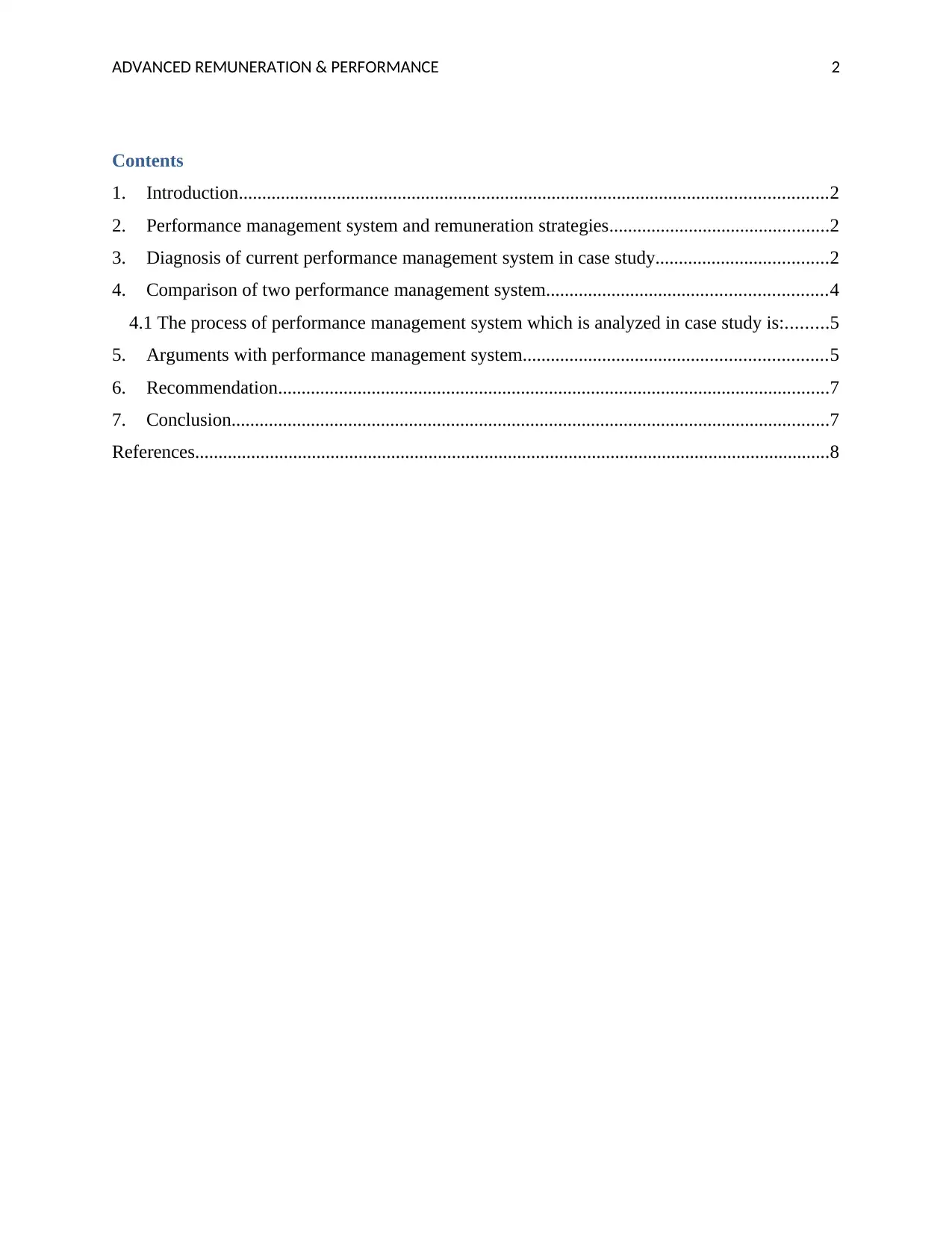
ADVANCED REMUNERATION & PERFORMANCE 2
Contents
1. Introduction..............................................................................................................................2
2. Performance management system and remuneration strategies...............................................2
3. Diagnosis of current performance management system in case study.....................................2
4. Comparison of two performance management system............................................................4
4.1 The process of performance management system which is analyzed in case study is:.........5
5. Arguments with performance management system.................................................................5
6. Recommendation......................................................................................................................7
7. Conclusion................................................................................................................................7
References........................................................................................................................................8
Contents
1. Introduction..............................................................................................................................2
2. Performance management system and remuneration strategies...............................................2
3. Diagnosis of current performance management system in case study.....................................2
4. Comparison of two performance management system............................................................4
4.1 The process of performance management system which is analyzed in case study is:.........5
5. Arguments with performance management system.................................................................5
6. Recommendation......................................................................................................................7
7. Conclusion................................................................................................................................7
References........................................................................................................................................8
⊘ This is a preview!⊘
Do you want full access?
Subscribe today to unlock all pages.

Trusted by 1+ million students worldwide
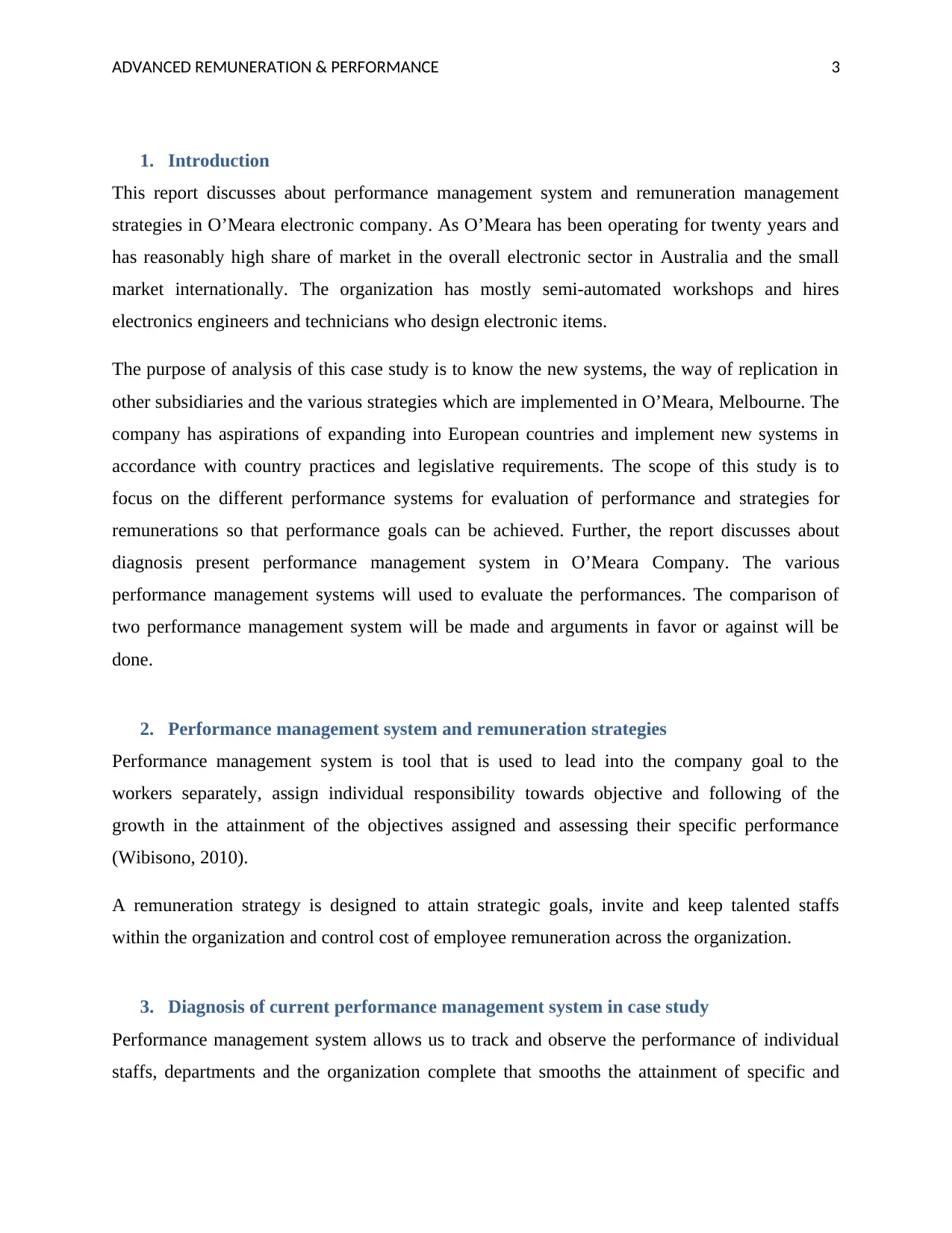
ADVANCED REMUNERATION & PERFORMANCE 3
1. Introduction
This report discusses about performance management system and remuneration management
strategies in O’Meara electronic company. As O’Meara has been operating for twenty years and
has reasonably high share of market in the overall electronic sector in Australia and the small
market internationally. The organization has mostly semi-automated workshops and hires
electronics engineers and technicians who design electronic items.
The purpose of analysis of this case study is to know the new systems, the way of replication in
other subsidiaries and the various strategies which are implemented in O’Meara, Melbourne. The
company has aspirations of expanding into European countries and implement new systems in
accordance with country practices and legislative requirements. The scope of this study is to
focus on the different performance systems for evaluation of performance and strategies for
remunerations so that performance goals can be achieved. Further, the report discusses about
diagnosis present performance management system in O’Meara Company. The various
performance management systems will used to evaluate the performances. The comparison of
two performance management system will be made and arguments in favor or against will be
done.
2. Performance management system and remuneration strategies
Performance management system is tool that is used to lead into the company goal to the
workers separately, assign individual responsibility towards objective and following of the
growth in the attainment of the objectives assigned and assessing their specific performance
(Wibisono, 2010).
A remuneration strategy is designed to attain strategic goals, invite and keep talented staffs
within the organization and control cost of employee remuneration across the organization.
3. Diagnosis of current performance management system in case study
Performance management system allows us to track and observe the performance of individual
staffs, departments and the organization complete that smooths the attainment of specific and
1. Introduction
This report discusses about performance management system and remuneration management
strategies in O’Meara electronic company. As O’Meara has been operating for twenty years and
has reasonably high share of market in the overall electronic sector in Australia and the small
market internationally. The organization has mostly semi-automated workshops and hires
electronics engineers and technicians who design electronic items.
The purpose of analysis of this case study is to know the new systems, the way of replication in
other subsidiaries and the various strategies which are implemented in O’Meara, Melbourne. The
company has aspirations of expanding into European countries and implement new systems in
accordance with country practices and legislative requirements. The scope of this study is to
focus on the different performance systems for evaluation of performance and strategies for
remunerations so that performance goals can be achieved. Further, the report discusses about
diagnosis present performance management system in O’Meara Company. The various
performance management systems will used to evaluate the performances. The comparison of
two performance management system will be made and arguments in favor or against will be
done.
2. Performance management system and remuneration strategies
Performance management system is tool that is used to lead into the company goal to the
workers separately, assign individual responsibility towards objective and following of the
growth in the attainment of the objectives assigned and assessing their specific performance
(Wibisono, 2010).
A remuneration strategy is designed to attain strategic goals, invite and keep talented staffs
within the organization and control cost of employee remuneration across the organization.
3. Diagnosis of current performance management system in case study
Performance management system allows us to track and observe the performance of individual
staffs, departments and the organization complete that smooths the attainment of specific and
Paraphrase This Document
Need a fresh take? Get an instant paraphrase of this document with our AI Paraphraser
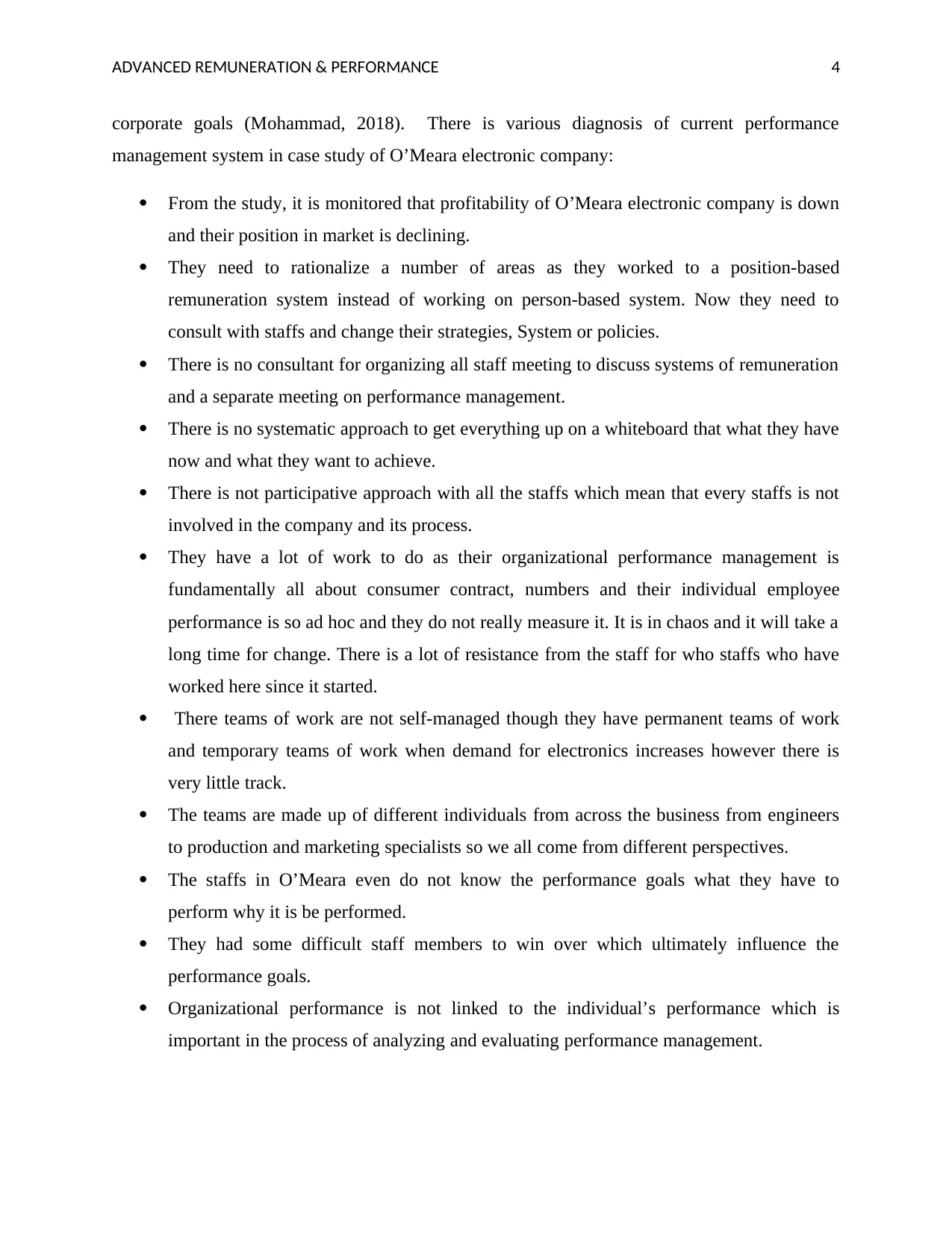
ADVANCED REMUNERATION & PERFORMANCE 4
corporate goals (Mohammad, 2018). There is various diagnosis of current performance
management system in case study of O’Meara electronic company:
From the study, it is monitored that profitability of O’Meara electronic company is down
and their position in market is declining.
They need to rationalize a number of areas as they worked to a position-based
remuneration system instead of working on person-based system. Now they need to
consult with staffs and change their strategies, System or policies.
There is no consultant for organizing all staff meeting to discuss systems of remuneration
and a separate meeting on performance management.
There is no systematic approach to get everything up on a whiteboard that what they have
now and what they want to achieve.
There is not participative approach with all the staffs which mean that every staffs is not
involved in the company and its process.
They have a lot of work to do as their organizational performance management is
fundamentally all about consumer contract, numbers and their individual employee
performance is so ad hoc and they do not really measure it. It is in chaos and it will take a
long time for change. There is a lot of resistance from the staff for who staffs who have
worked here since it started.
There teams of work are not self-managed though they have permanent teams of work
and temporary teams of work when demand for electronics increases however there is
very little track.
The teams are made up of different individuals from across the business from engineers
to production and marketing specialists so we all come from different perspectives.
The staffs in O’Meara even do not know the performance goals what they have to
perform why it is be performed.
They had some difficult staff members to win over which ultimately influence the
performance goals.
Organizational performance is not linked to the individual’s performance which is
important in the process of analyzing and evaluating performance management.
corporate goals (Mohammad, 2018). There is various diagnosis of current performance
management system in case study of O’Meara electronic company:
From the study, it is monitored that profitability of O’Meara electronic company is down
and their position in market is declining.
They need to rationalize a number of areas as they worked to a position-based
remuneration system instead of working on person-based system. Now they need to
consult with staffs and change their strategies, System or policies.
There is no consultant for organizing all staff meeting to discuss systems of remuneration
and a separate meeting on performance management.
There is no systematic approach to get everything up on a whiteboard that what they have
now and what they want to achieve.
There is not participative approach with all the staffs which mean that every staffs is not
involved in the company and its process.
They have a lot of work to do as their organizational performance management is
fundamentally all about consumer contract, numbers and their individual employee
performance is so ad hoc and they do not really measure it. It is in chaos and it will take a
long time for change. There is a lot of resistance from the staff for who staffs who have
worked here since it started.
There teams of work are not self-managed though they have permanent teams of work
and temporary teams of work when demand for electronics increases however there is
very little track.
The teams are made up of different individuals from across the business from engineers
to production and marketing specialists so we all come from different perspectives.
The staffs in O’Meara even do not know the performance goals what they have to
perform why it is be performed.
They had some difficult staff members to win over which ultimately influence the
performance goals.
Organizational performance is not linked to the individual’s performance which is
important in the process of analyzing and evaluating performance management.
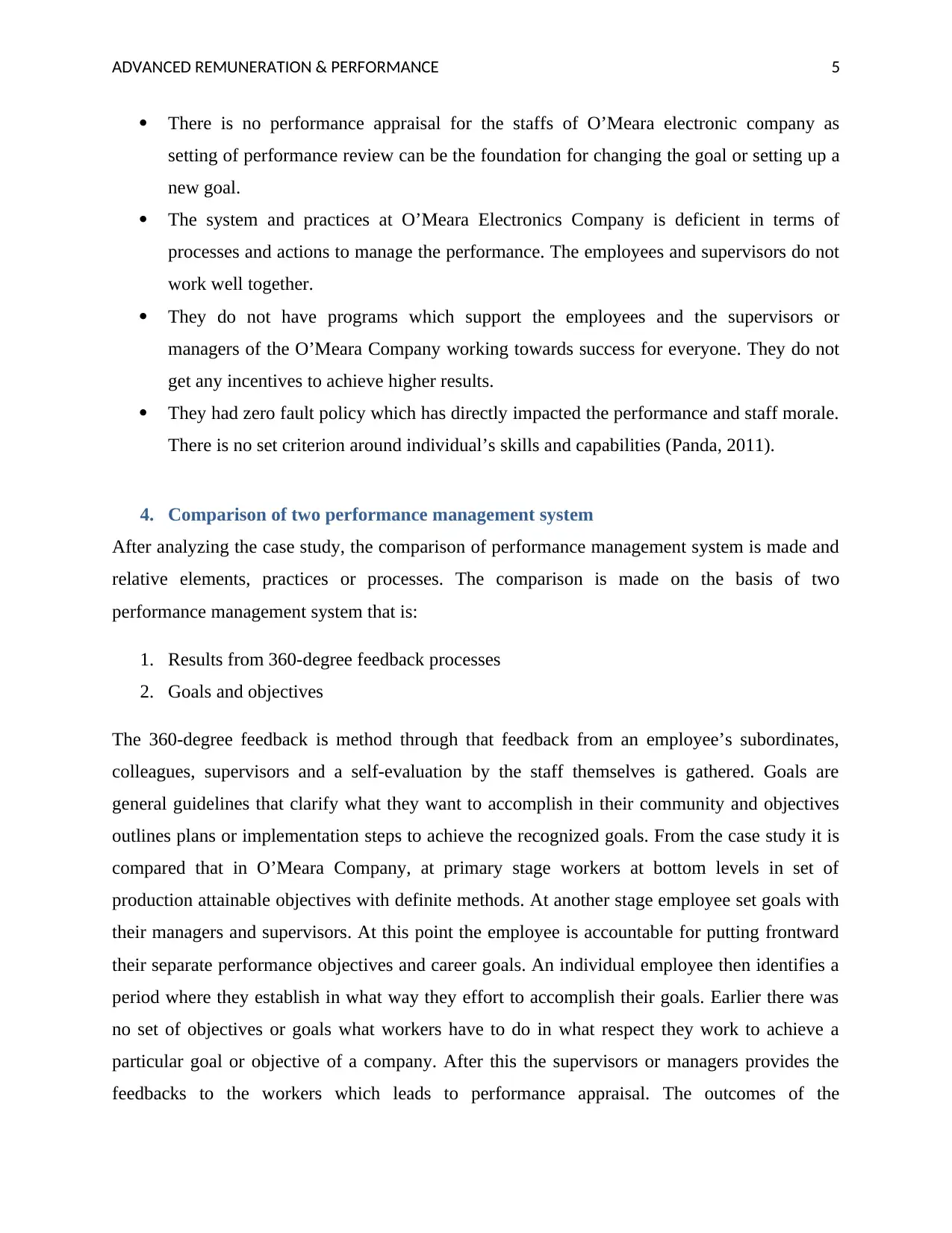
ADVANCED REMUNERATION & PERFORMANCE 5
There is no performance appraisal for the staffs of O’Meara electronic company as
setting of performance review can be the foundation for changing the goal or setting up a
new goal.
The system and practices at O’Meara Electronics Company is deficient in terms of
processes and actions to manage the performance. The employees and supervisors do not
work well together.
They do not have programs which support the employees and the supervisors or
managers of the O’Meara Company working towards success for everyone. They do not
get any incentives to achieve higher results.
They had zero fault policy which has directly impacted the performance and staff morale.
There is no set criterion around individual’s skills and capabilities (Panda, 2011).
4. Comparison of two performance management system
After analyzing the case study, the comparison of performance management system is made and
relative elements, practices or processes. The comparison is made on the basis of two
performance management system that is:
1. Results from 360-degree feedback processes
2. Goals and objectives
The 360-degree feedback is method through that feedback from an employee’s subordinates,
colleagues, supervisors and a self-evaluation by the staff themselves is gathered. Goals are
general guidelines that clarify what they want to accomplish in their community and objectives
outlines plans or implementation steps to achieve the recognized goals. From the case study it is
compared that in O’Meara Company, at primary stage workers at bottom levels in set of
production attainable objectives with definite methods. At another stage employee set goals with
their managers and supervisors. At this point the employee is accountable for putting frontward
their separate performance objectives and career goals. An individual employee then identifies a
period where they establish in what way they effort to accomplish their goals. Earlier there was
no set of objectives or goals what workers have to do in what respect they work to achieve a
particular goal or objective of a company. After this the supervisors or managers provides the
feedbacks to the workers which leads to performance appraisal. The outcomes of the
There is no performance appraisal for the staffs of O’Meara electronic company as
setting of performance review can be the foundation for changing the goal or setting up a
new goal.
The system and practices at O’Meara Electronics Company is deficient in terms of
processes and actions to manage the performance. The employees and supervisors do not
work well together.
They do not have programs which support the employees and the supervisors or
managers of the O’Meara Company working towards success for everyone. They do not
get any incentives to achieve higher results.
They had zero fault policy which has directly impacted the performance and staff morale.
There is no set criterion around individual’s skills and capabilities (Panda, 2011).
4. Comparison of two performance management system
After analyzing the case study, the comparison of performance management system is made and
relative elements, practices or processes. The comparison is made on the basis of two
performance management system that is:
1. Results from 360-degree feedback processes
2. Goals and objectives
The 360-degree feedback is method through that feedback from an employee’s subordinates,
colleagues, supervisors and a self-evaluation by the staff themselves is gathered. Goals are
general guidelines that clarify what they want to accomplish in their community and objectives
outlines plans or implementation steps to achieve the recognized goals. From the case study it is
compared that in O’Meara Company, at primary stage workers at bottom levels in set of
production attainable objectives with definite methods. At another stage employee set goals with
their managers and supervisors. At this point the employee is accountable for putting frontward
their separate performance objectives and career goals. An individual employee then identifies a
period where they establish in what way they effort to accomplish their goals. Earlier there was
no set of objectives or goals what workers have to do in what respect they work to achieve a
particular goal or objective of a company. After this the supervisors or managers provides the
feedbacks to the workers which leads to performance appraisal. The outcomes of the
⊘ This is a preview!⊘
Do you want full access?
Subscribe today to unlock all pages.

Trusted by 1+ million students worldwide
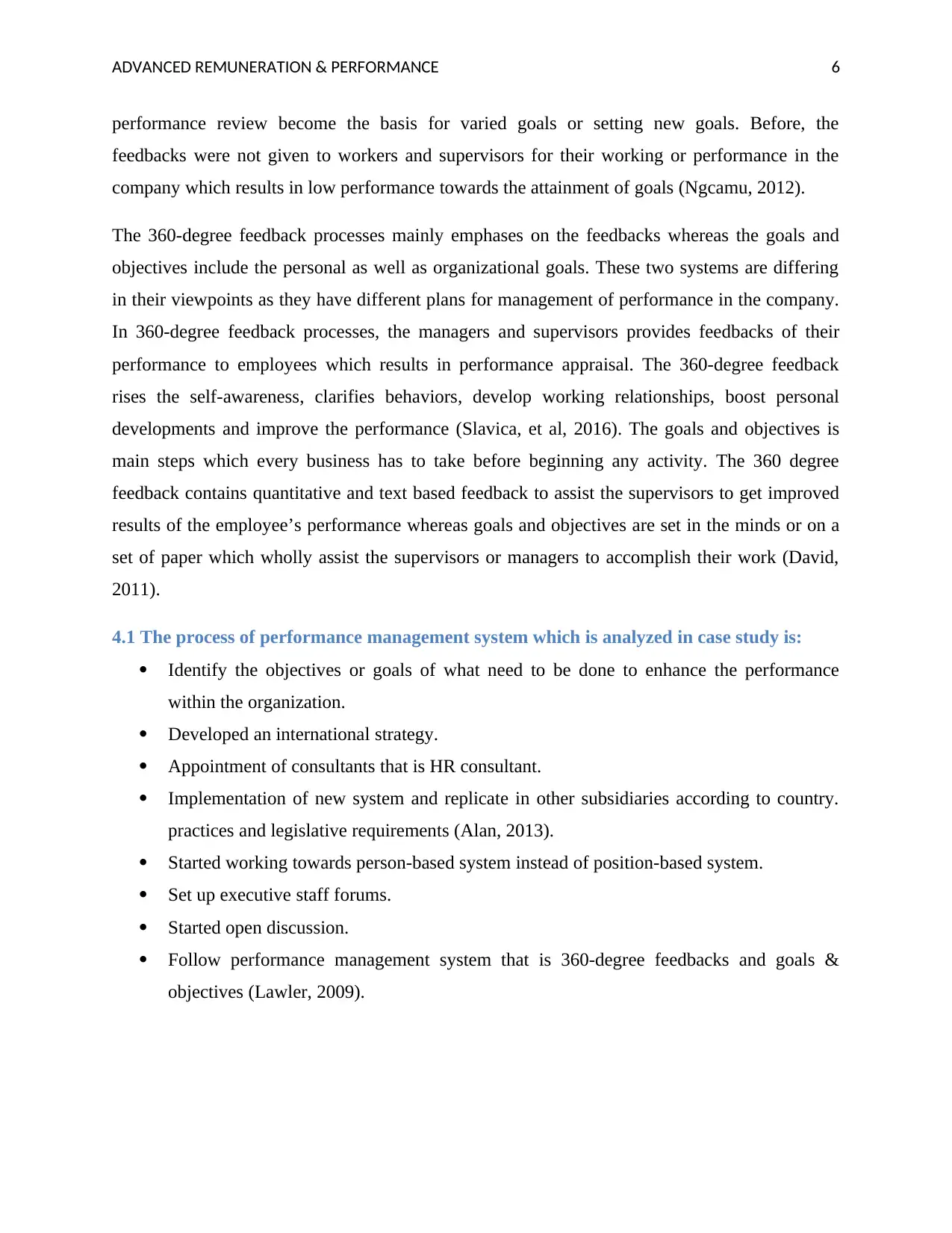
ADVANCED REMUNERATION & PERFORMANCE 6
performance review become the basis for varied goals or setting new goals. Before, the
feedbacks were not given to workers and supervisors for their working or performance in the
company which results in low performance towards the attainment of goals (Ngcamu, 2012).
The 360-degree feedback processes mainly emphases on the feedbacks whereas the goals and
objectives include the personal as well as organizational goals. These two systems are differing
in their viewpoints as they have different plans for management of performance in the company.
In 360-degree feedback processes, the managers and supervisors provides feedbacks of their
performance to employees which results in performance appraisal. The 360-degree feedback
rises the self-awareness, clarifies behaviors, develop working relationships, boost personal
developments and improve the performance (Slavica, et al, 2016). The goals and objectives is
main steps which every business has to take before beginning any activity. The 360 degree
feedback contains quantitative and text based feedback to assist the supervisors to get improved
results of the employee’s performance whereas goals and objectives are set in the minds or on a
set of paper which wholly assist the supervisors or managers to accomplish their work (David,
2011).
4.1 The process of performance management system which is analyzed in case study is:
Identify the objectives or goals of what need to be done to enhance the performance
within the organization.
Developed an international strategy.
Appointment of consultants that is HR consultant.
Implementation of new system and replicate in other subsidiaries according to country.
practices and legislative requirements (Alan, 2013).
Started working towards person-based system instead of position-based system.
Set up executive staff forums.
Started open discussion.
Follow performance management system that is 360-degree feedbacks and goals &
objectives (Lawler, 2009).
performance review become the basis for varied goals or setting new goals. Before, the
feedbacks were not given to workers and supervisors for their working or performance in the
company which results in low performance towards the attainment of goals (Ngcamu, 2012).
The 360-degree feedback processes mainly emphases on the feedbacks whereas the goals and
objectives include the personal as well as organizational goals. These two systems are differing
in their viewpoints as they have different plans for management of performance in the company.
In 360-degree feedback processes, the managers and supervisors provides feedbacks of their
performance to employees which results in performance appraisal. The 360-degree feedback
rises the self-awareness, clarifies behaviors, develop working relationships, boost personal
developments and improve the performance (Slavica, et al, 2016). The goals and objectives is
main steps which every business has to take before beginning any activity. The 360 degree
feedback contains quantitative and text based feedback to assist the supervisors to get improved
results of the employee’s performance whereas goals and objectives are set in the minds or on a
set of paper which wholly assist the supervisors or managers to accomplish their work (David,
2011).
4.1 The process of performance management system which is analyzed in case study is:
Identify the objectives or goals of what need to be done to enhance the performance
within the organization.
Developed an international strategy.
Appointment of consultants that is HR consultant.
Implementation of new system and replicate in other subsidiaries according to country.
practices and legislative requirements (Alan, 2013).
Started working towards person-based system instead of position-based system.
Set up executive staff forums.
Started open discussion.
Follow performance management system that is 360-degree feedbacks and goals &
objectives (Lawler, 2009).
Paraphrase This Document
Need a fresh take? Get an instant paraphrase of this document with our AI Paraphraser
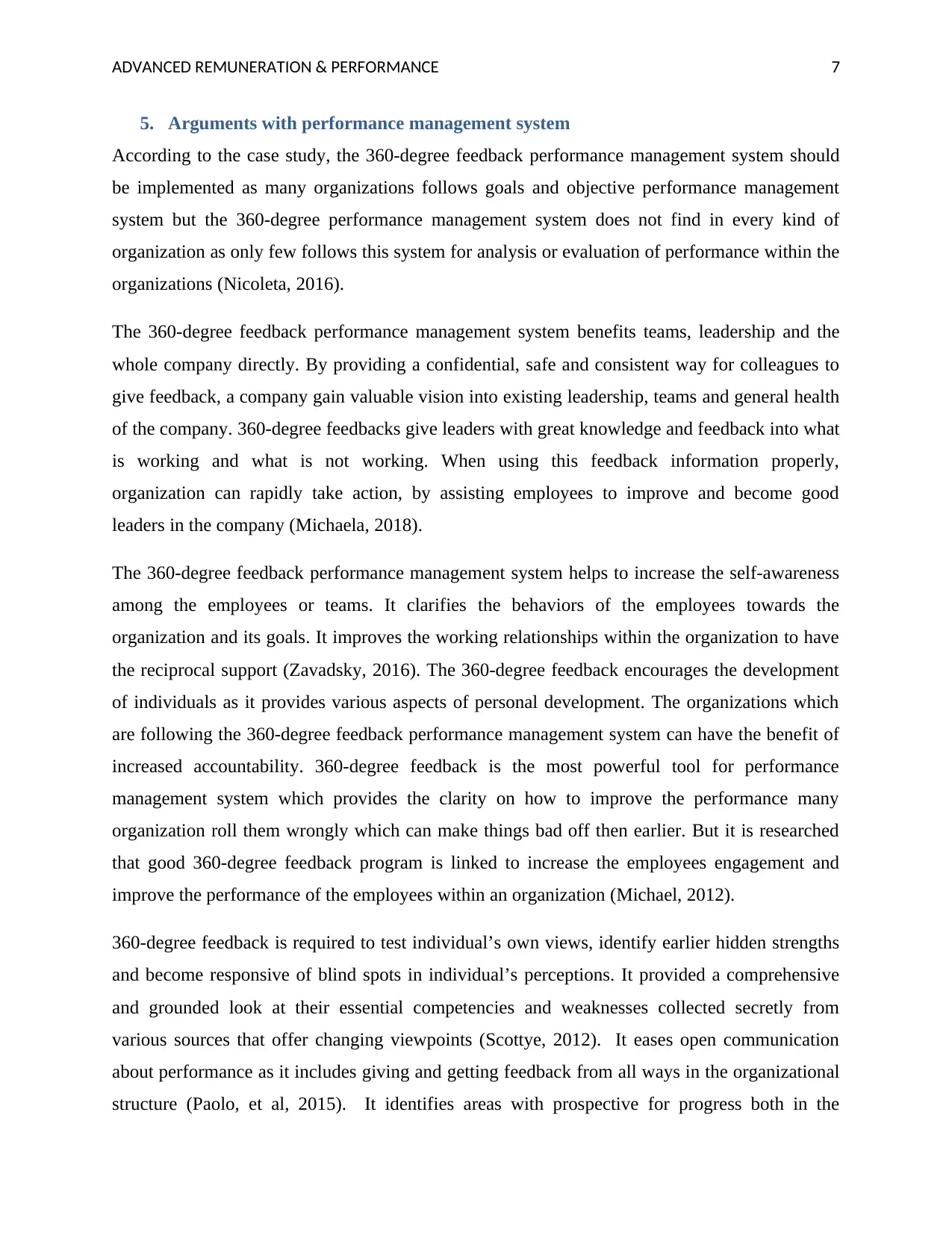
ADVANCED REMUNERATION & PERFORMANCE 7
5. Arguments with performance management system
According to the case study, the 360-degree feedback performance management system should
be implemented as many organizations follows goals and objective performance management
system but the 360-degree performance management system does not find in every kind of
organization as only few follows this system for analysis or evaluation of performance within the
organizations (Nicoleta, 2016).
The 360-degree feedback performance management system benefits teams, leadership and the
whole company directly. By providing a confidential, safe and consistent way for colleagues to
give feedback, a company gain valuable vision into existing leadership, teams and general health
of the company. 360-degree feedbacks give leaders with great knowledge and feedback into what
is working and what is not working. When using this feedback information properly,
organization can rapidly take action, by assisting employees to improve and become good
leaders in the company (Michaela, 2018).
The 360-degree feedback performance management system helps to increase the self-awareness
among the employees or teams. It clarifies the behaviors of the employees towards the
organization and its goals. It improves the working relationships within the organization to have
the reciprocal support (Zavadsky, 2016). The 360-degree feedback encourages the development
of individuals as it provides various aspects of personal development. The organizations which
are following the 360-degree feedback performance management system can have the benefit of
increased accountability. 360-degree feedback is the most powerful tool for performance
management system which provides the clarity on how to improve the performance many
organization roll them wrongly which can make things bad off then earlier. But it is researched
that good 360-degree feedback program is linked to increase the employees engagement and
improve the performance of the employees within an organization (Michael, 2012).
360-degree feedback is required to test individual’s own views, identify earlier hidden strengths
and become responsive of blind spots in individual’s perceptions. It provided a comprehensive
and grounded look at their essential competencies and weaknesses collected secretly from
various sources that offer changing viewpoints (Scottye, 2012). It eases open communication
about performance as it includes giving and getting feedback from all ways in the organizational
structure (Paolo, et al, 2015). It identifies areas with prospective for progress both in the
5. Arguments with performance management system
According to the case study, the 360-degree feedback performance management system should
be implemented as many organizations follows goals and objective performance management
system but the 360-degree performance management system does not find in every kind of
organization as only few follows this system for analysis or evaluation of performance within the
organizations (Nicoleta, 2016).
The 360-degree feedback performance management system benefits teams, leadership and the
whole company directly. By providing a confidential, safe and consistent way for colleagues to
give feedback, a company gain valuable vision into existing leadership, teams and general health
of the company. 360-degree feedbacks give leaders with great knowledge and feedback into what
is working and what is not working. When using this feedback information properly,
organization can rapidly take action, by assisting employees to improve and become good
leaders in the company (Michaela, 2018).
The 360-degree feedback performance management system helps to increase the self-awareness
among the employees or teams. It clarifies the behaviors of the employees towards the
organization and its goals. It improves the working relationships within the organization to have
the reciprocal support (Zavadsky, 2016). The 360-degree feedback encourages the development
of individuals as it provides various aspects of personal development. The organizations which
are following the 360-degree feedback performance management system can have the benefit of
increased accountability. 360-degree feedback is the most powerful tool for performance
management system which provides the clarity on how to improve the performance many
organization roll them wrongly which can make things bad off then earlier. But it is researched
that good 360-degree feedback program is linked to increase the employees engagement and
improve the performance of the employees within an organization (Michael, 2012).
360-degree feedback is required to test individual’s own views, identify earlier hidden strengths
and become responsive of blind spots in individual’s perceptions. It provided a comprehensive
and grounded look at their essential competencies and weaknesses collected secretly from
various sources that offer changing viewpoints (Scottye, 2012). It eases open communication
about performance as it includes giving and getting feedback from all ways in the organizational
structure (Paolo, et al, 2015). It identifies areas with prospective for progress both in the
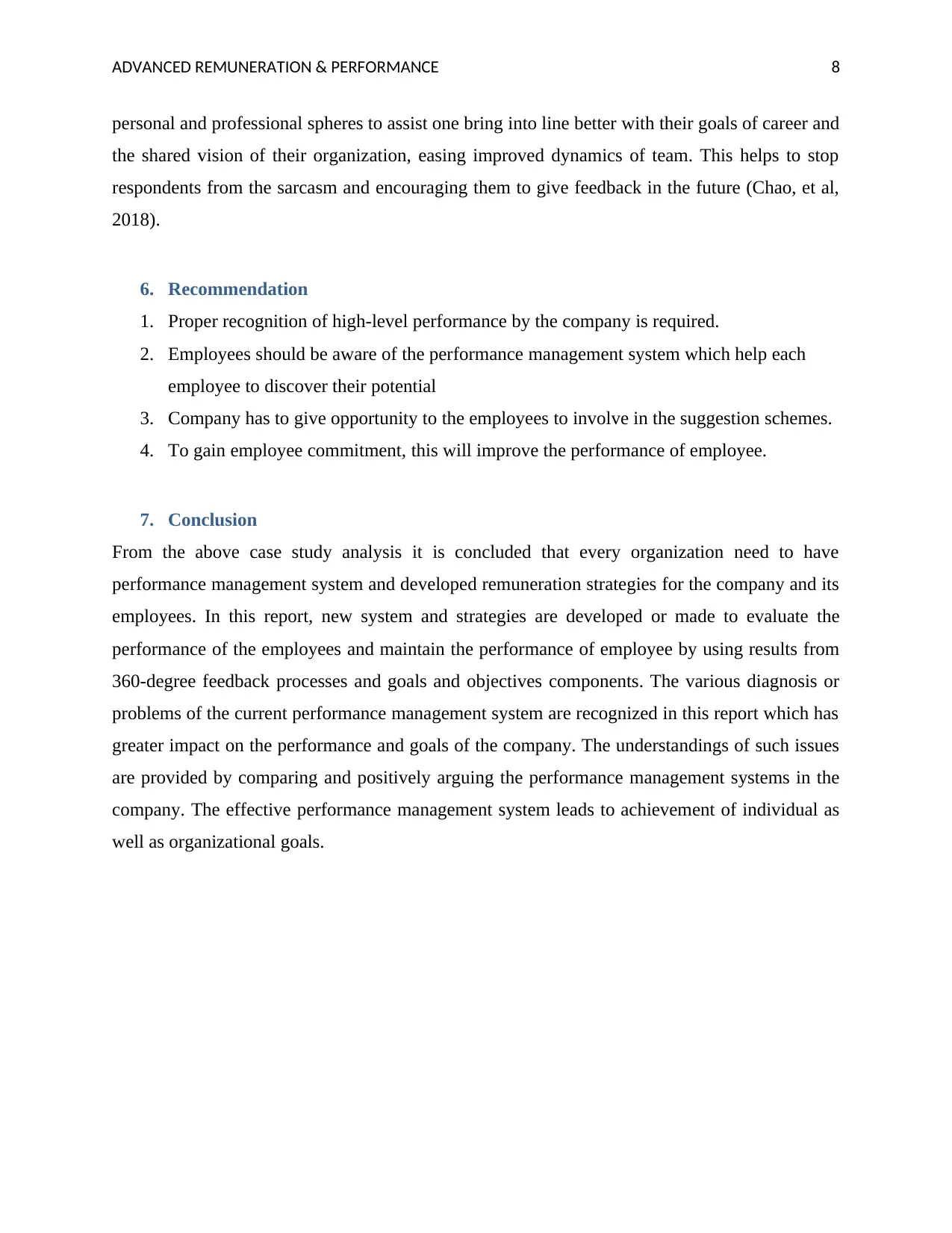
ADVANCED REMUNERATION & PERFORMANCE 8
personal and professional spheres to assist one bring into line better with their goals of career and
the shared vision of their organization, easing improved dynamics of team. This helps to stop
respondents from the sarcasm and encouraging them to give feedback in the future (Chao, et al,
2018).
6. Recommendation
1. Proper recognition of high-level performance by the company is required.
2. Employees should be aware of the performance management system which help each
employee to discover their potential
3. Company has to give opportunity to the employees to involve in the suggestion schemes.
4. To gain employee commitment, this will improve the performance of employee.
7. Conclusion
From the above case study analysis it is concluded that every organization need to have
performance management system and developed remuneration strategies for the company and its
employees. In this report, new system and strategies are developed or made to evaluate the
performance of the employees and maintain the performance of employee by using results from
360-degree feedback processes and goals and objectives components. The various diagnosis or
problems of the current performance management system are recognized in this report which has
greater impact on the performance and goals of the company. The understandings of such issues
are provided by comparing and positively arguing the performance management systems in the
company. The effective performance management system leads to achievement of individual as
well as organizational goals.
personal and professional spheres to assist one bring into line better with their goals of career and
the shared vision of their organization, easing improved dynamics of team. This helps to stop
respondents from the sarcasm and encouraging them to give feedback in the future (Chao, et al,
2018).
6. Recommendation
1. Proper recognition of high-level performance by the company is required.
2. Employees should be aware of the performance management system which help each
employee to discover their potential
3. Company has to give opportunity to the employees to involve in the suggestion schemes.
4. To gain employee commitment, this will improve the performance of employee.
7. Conclusion
From the above case study analysis it is concluded that every organization need to have
performance management system and developed remuneration strategies for the company and its
employees. In this report, new system and strategies are developed or made to evaluate the
performance of the employees and maintain the performance of employee by using results from
360-degree feedback processes and goals and objectives components. The various diagnosis or
problems of the current performance management system are recognized in this report which has
greater impact on the performance and goals of the company. The understandings of such issues
are provided by comparing and positively arguing the performance management systems in the
company. The effective performance management system leads to achievement of individual as
well as organizational goals.
⊘ This is a preview!⊘
Do you want full access?
Subscribe today to unlock all pages.

Trusted by 1+ million students worldwide
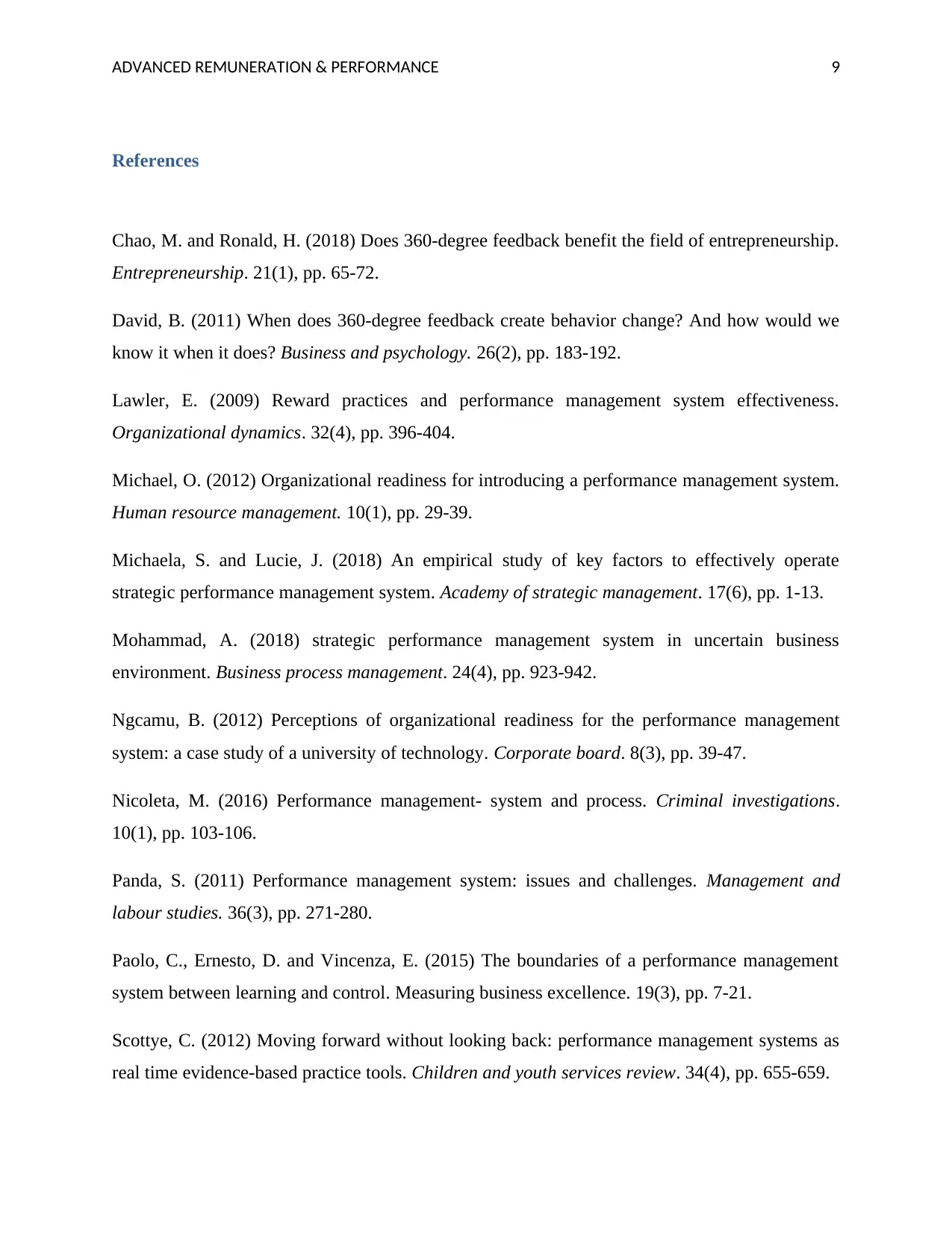
ADVANCED REMUNERATION & PERFORMANCE 9
References
Chao, M. and Ronald, H. (2018) Does 360-degree feedback benefit the field of entrepreneurship.
Entrepreneurship. 21(1), pp. 65-72.
David, B. (2011) When does 360-degree feedback create behavior change? And how would we
know it when it does? Business and psychology. 26(2), pp. 183-192.
Lawler, E. (2009) Reward practices and performance management system effectiveness.
Organizational dynamics. 32(4), pp. 396-404.
Michael, O. (2012) Organizational readiness for introducing a performance management system.
Human resource management. 10(1), pp. 29-39.
Michaela, S. and Lucie, J. (2018) An empirical study of key factors to effectively operate
strategic performance management system. Academy of strategic management. 17(6), pp. 1-13.
Mohammad, A. (2018) strategic performance management system in uncertain business
environment. Business process management. 24(4), pp. 923-942.
Ngcamu, B. (2012) Perceptions of organizational readiness for the performance management
system: a case study of a university of technology. Corporate board. 8(3), pp. 39-47.
Nicoleta, M. (2016) Performance management- system and process. Criminal investigations.
10(1), pp. 103-106.
Panda, S. (2011) Performance management system: issues and challenges. Management and
labour studies. 36(3), pp. 271-280.
Paolo, C., Ernesto, D. and Vincenza, E. (2015) The boundaries of a performance management
system between learning and control. Measuring business excellence. 19(3), pp. 7-21.
Scottye, C. (2012) Moving forward without looking back: performance management systems as
real time evidence-based practice tools. Children and youth services review. 34(4), pp. 655-659.
References
Chao, M. and Ronald, H. (2018) Does 360-degree feedback benefit the field of entrepreneurship.
Entrepreneurship. 21(1), pp. 65-72.
David, B. (2011) When does 360-degree feedback create behavior change? And how would we
know it when it does? Business and psychology. 26(2), pp. 183-192.
Lawler, E. (2009) Reward practices and performance management system effectiveness.
Organizational dynamics. 32(4), pp. 396-404.
Michael, O. (2012) Organizational readiness for introducing a performance management system.
Human resource management. 10(1), pp. 29-39.
Michaela, S. and Lucie, J. (2018) An empirical study of key factors to effectively operate
strategic performance management system. Academy of strategic management. 17(6), pp. 1-13.
Mohammad, A. (2018) strategic performance management system in uncertain business
environment. Business process management. 24(4), pp. 923-942.
Ngcamu, B. (2012) Perceptions of organizational readiness for the performance management
system: a case study of a university of technology. Corporate board. 8(3), pp. 39-47.
Nicoleta, M. (2016) Performance management- system and process. Criminal investigations.
10(1), pp. 103-106.
Panda, S. (2011) Performance management system: issues and challenges. Management and
labour studies. 36(3), pp. 271-280.
Paolo, C., Ernesto, D. and Vincenza, E. (2015) The boundaries of a performance management
system between learning and control. Measuring business excellence. 19(3), pp. 7-21.
Scottye, C. (2012) Moving forward without looking back: performance management systems as
real time evidence-based practice tools. Children and youth services review. 34(4), pp. 655-659.
Paraphrase This Document
Need a fresh take? Get an instant paraphrase of this document with our AI Paraphraser
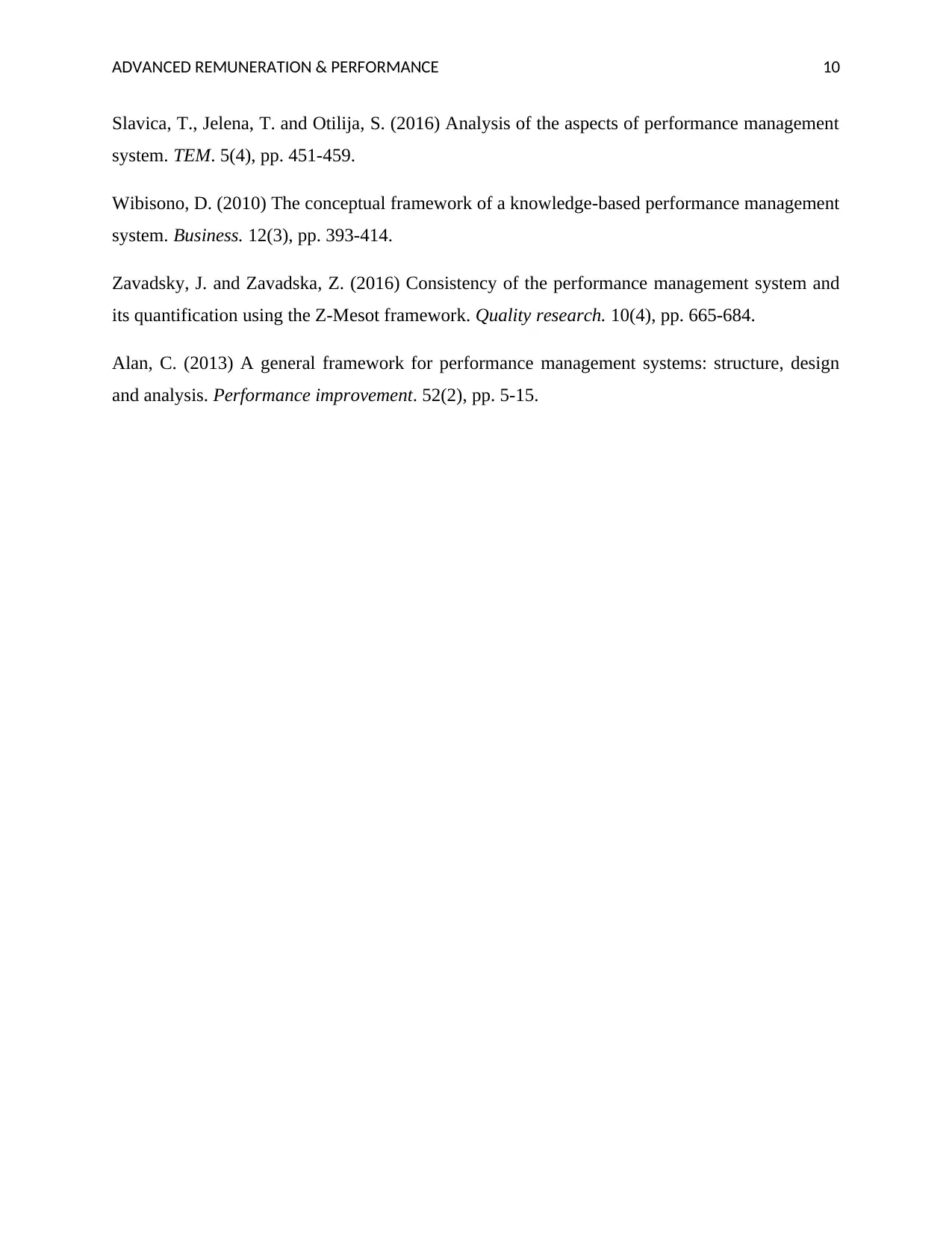
ADVANCED REMUNERATION & PERFORMANCE 10
Slavica, T., Jelena, T. and Otilija, S. (2016) Analysis of the aspects of performance management
system. TEM. 5(4), pp. 451-459.
Wibisono, D. (2010) The conceptual framework of a knowledge-based performance management
system. Business. 12(3), pp. 393-414.
Zavadsky, J. and Zavadska, Z. (2016) Consistency of the performance management system and
its quantification using the Z-Mesot framework. Quality research. 10(4), pp. 665-684.
Alan, C. (2013) A general framework for performance management systems: structure, design
and analysis. Performance improvement. 52(2), pp. 5-15.
Slavica, T., Jelena, T. and Otilija, S. (2016) Analysis of the aspects of performance management
system. TEM. 5(4), pp. 451-459.
Wibisono, D. (2010) The conceptual framework of a knowledge-based performance management
system. Business. 12(3), pp. 393-414.
Zavadsky, J. and Zavadska, Z. (2016) Consistency of the performance management system and
its quantification using the Z-Mesot framework. Quality research. 10(4), pp. 665-684.
Alan, C. (2013) A general framework for performance management systems: structure, design
and analysis. Performance improvement. 52(2), pp. 5-15.
1 out of 11
Related Documents
Your All-in-One AI-Powered Toolkit for Academic Success.
+13062052269
info@desklib.com
Available 24*7 on WhatsApp / Email
![[object Object]](/_next/static/media/star-bottom.7253800d.svg)
Unlock your academic potential
Copyright © 2020–2025 A2Z Services. All Rights Reserved. Developed and managed by ZUCOL.


